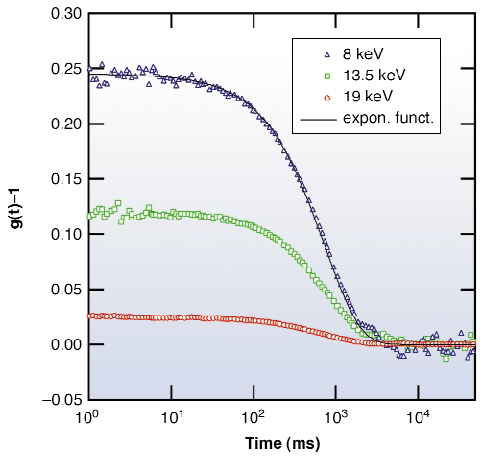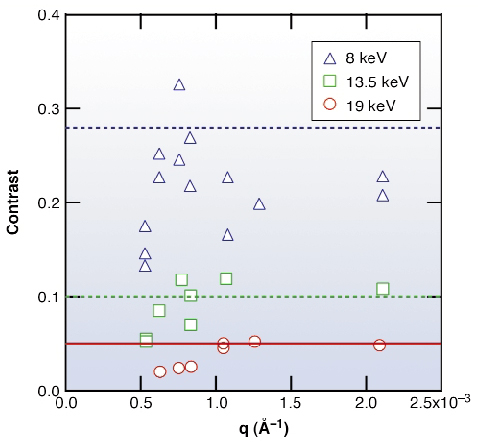- Home
- Users & Science
- Scientific Documentation
- ESRF Highlights
- ESRF Highlights 2003
- Soft Condensed Matter
- Photon Correlation Spectroscopy with High-energy Coherent X-rays
Photon Correlation Spectroscopy with High-energy Coherent X-rays
X-ray photon correlation spectroscopy (XPCS) allows measurement of slow dynamics on a small spatial scale in a scattering experiment [1, 2]. Since its development the technique has been used to explore the dynamics of a variety of colloidal and liquid crystal systems. Applications to polymer systems, although of basic interest, have been limited, partly due to severe problems with radiation damage. While it is known that radiation damage to organic samples can be reduced substantially by using higher-energy radiation, such an approach has never been seriously explored for XPCS experiments, since in these experiments a coherent primary beam is needed and coherent flux from a synchrotron source scales with the square of the wavelength. A positive aspect of higher-energy X-rays is the reduced absorption, which allows one to use thicker samples and longer acquisition times. We demonstrated that XPCS experiments can indeed be performed with higher-energy X-rays (~ 20 keV) and, based on scaling arguments we argue that despite a loss of coherence it will often be possible to realise a gain in signal to noise ratio under circumstances where thick samples can be used.
X-ray photon correlation spectroscopy is based on the same concept as the more commonly known Dynamic Light Scattering technique except for the use of coherent X-rays. If a scattering experiment is performed under highly-coherent conditions, the scattering pattern exhibits random interferences, so called 'speckles'. Microscopic dynamics in the sample leads to fluctuations in the speckle pattern and the corresponding intensity fluctuations constitute the signal observed in photon correlation spectroscopy. The intensity fluctuations are quantified via a normalised intensity correlation function g(q, t), which for simple translational diffusion can be modeled by an exponential function
g(t) = c(q,![]() ) exp(2Dq2) + 1
) exp(2Dq2) + 1
Here c(q, ![]() ) is the contrast of the correlation function and D the diffusion constant. c(q,
) is the contrast of the correlation function and D the diffusion constant. c(q, ![]() ) is a direct measure of coherence.
) is a direct measure of coherence.
 |
|
Fig. 73: Exemplary correlation functions of colloidal silica suspension measured at q ~ 7.6 x 10-4Å-1 using three different X-ray energies as indicated. |
We performed X-ray photon correlation spectroscopy experiments at the new Troika III station of beamline ID10A on a model suspension of colloidal particles using X-rays of three different energies. Exemplary correlation functions are shown in Figure 73. As expected we observe a strong change in contrast, i.e. coherence, while the time scale, on which the correlation functions decay, remains unchanged. The contrast of a series of correlation functions taken at different energies is shown in Figure 74. The dotted lines indicate the expected value of the contrast based on an extrapolation from the value determined for Ex = 19 keV. The estimated values are consistent with the data, although there are deviations, especially at 8 keV, which are most likely caused by static background signal. These results give an experimental basis to our arguments concerning the statistics of XPCS measurements at different energies. In conclusion, our data clearly show that it is feasible to perform XPCS experiments with higher X-ray energies than used in previous experiments. The reduced absorption can be used for a net gain in signal if sample thickness and acquisition time are optimised. The use of higher energy X-rays constitutes a promising option for future XPCS-experiments on polymeric and biological sample systems.
 |
|
Fig. 74: Contrast c(q, |
References
[1] S.G.J. Mochrie, A.M. Mayes, A.R. Sandy, M. Sutton, S. Brauer, G.B. Stephenson, D.L. Abernathy and G. Grübel, Phys. Rev. Lett. 78, 1275 (1996).
[2] T. Thurn-Albrecht, W. Steffen, A. Patkowski, G. Meier, E. W. Fischer, G. Grübel, and D.L. Abernathy, Phys. Rev. Lett. 77, 5437 (1996).
Principal Publication and Authors
T. Thurn-Albrecht (a), F. Zontone (b), G. Grübel (b), W. Steffen (c), P.Müller-Buschbaum (d), A. Patkowski (e), Phys. Rev. E 68, 031407 (2003).
(a) Martin-Luther-University Halle (Germany)
(b) ESRF
(c) Max-Planck-Institute for Polymer Research, Mainz (Germany)
(d) Technische Universität München, Garching (Germany)
(e) A. Mickiewicz University, Poznan (Poland)



